American
Whiskey
September 12 - 16,
2001 -- The Kentucky
Bourbon
Festival
The Tenth Annual
Kentucky Bourbon Festival
Bardstown, Kentucky |
|
 |
Oh Beautiful
For Spacious Skies,
For Amber Waves of
Grain...
BOURBON WHISKEY is no stranger to violence and
death, no matter if it's on a wild and rowdy Saturday night or a bright and
peaceful Tuesday morning. Bourbon marched with Americans wearing both grey
and blue a hundred and forty years ago and it was the preferred spirit of
the American president who ended the most violent war we ever fought with
the most violent weapon ever used. That would have been Give-'em-Hell Harry
Truman, of course.
 The
history of bourbon and the history of America are very much one and the same.
And, unfortunately, the premier celebration of this noble spirit coincided
this year with a tragic event that will forever be engraved in our hearts
and in American history.
The
history of bourbon and the history of America are very much one and the same.
And, unfortunately, the premier celebration of this noble spirit coincided
this year with a tragic event that will forever be engraved in our hearts
and in American history.
Over 5,000 souls were lost yesterday morning, and untold numbers of people
were directly affected by the horror of that terrorist attack. It's not
impossible that some of those who lost their lives had intended to be in
Bardstown this week to attend the Tenth Annual Kentucky Bourbon Festival.
Among the millions who make up the rest of America, some of those who would
have attended were too emotionally torn by the gravity of events to even
consider a celebration. Others, like ourselves, struggled long and hard over
the decision. And among those, many still chose not to attend. After calling
the Festival Committee and learning that the board had met and voted not
to cancel, we decided to go.
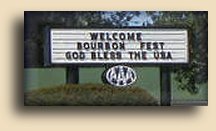 There
were very many others who did the same.
There
were very many others who did the same.
And for most, that wasn't as easy as our jumping into the car and driving
a couple hours. As of Wednesday morning, all domestic air traffic over the
United States was still grounded. There were rumors that flights might resume
by this afternoon, but nothing was certain yet. And of course other public
transportation was a nightmare of congestion as people with much more pressing
needs than a bourbon festival tried to get from where they were to where
they needed to be. And no one was even speculating about foreign flights.
Yesterday, those were diverted to Canadian and other non-U.S. airports, and
they are not expected to resume right away even after domestic flights start
back up.
But people got here. Lots of people. From all over. In some very creative
ways. Of course, many who would otherwise have flown ended up driving long
distances to get here. Such as Kris and Chris, a young couple from New York
who had intended to fly to Kentucky, but ended up driving instead... straight
through, nonstop. Another gentleman used his talents to secure a seat on
the first commercial airliner out of Miami on Thursday, only to find himself
stuck in Atlanta with no such thing as a connecting flight. He managed to
find the pilot of a small plane, convinced him to fly him to Lexington
where he rented a car, and then drove the rest of the way. Some people from
Japan, unable to get a flight into America, went to Vancouver, in Canada,
then rented a car there and drove it to Seattle, Washington, and then were
eventually able to get a flight from there to Louisville.
WEDNESDAY
-
SEPTEMBER
12,
2001
THERE'S A GREAT deal of speculation
about who's
going and when. Linn & Vickie Spencer, who we met here last year, are
driving in from Virginia and expect to arrive around six. Our Cincinnati
friends Marvin and Evelyn Franz are taking their time and expect to get there
late in the afternoon. We spend a leisurely morning and figure on arriving
in mid-afternoon, well ahead of anyone... WRONG!
Marvin calls us on our cell phone while we're on our way, asking
where we are. They're already in Bardstown and ready for lunch. When we arrive
at the Best Western General Nelson
Motel, our traditional favorite, Linn, Vickie and Bill Legge are
already there. Bill is another friend we met originally here on the internet
and kept in touch with, mainly through a bulletin board forum. Bill also
has an excellent site of his own
(http://home.kc.rr.com/mashbill).
If you're interested in bourbon you might want to wander over there for
a look. We grab the bottles we brought and join them before we even take
the time to unpack the car.
|
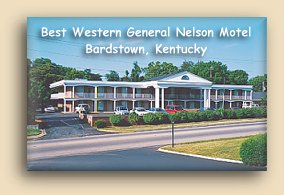
|
This is our fourth year of attending the Kentucky Bourbon Festival, and
we've chronicled two others in these pages already. So if you want to get
a good idea of what the festival is, and how it all came about, and how it
all works, and just a whole bunch of other neat stuff, click here to check
out each of the other two years (we didn't do a web page for 1999) and then
come back to this page.
  |
We exchange bottles of hard-to-find bourbons that we'd brought for each other,
taste different bourbons, and just talk. Bill and Linn have brought along
a few of their favorite pistols (they're both collectors and shooters) and
they're showing them off. Both are customizers and proud of the modifications
they've made. I guess it's a lot like hot rodders or computer geeks ("Oh
it's basically a stock Binford .4557, but I've replaced the handle, the barrel,
the trigger, the front and rear sights, the safety catch, and the action.
And I added a dual-action, water-cooled frammis guard"). They're hoping
to find a place to do some shooting. Linn has come up with a great idea for
a contest, using a ten-dollar bill as a target. That would relate the whole
event to bourbon history, as the object would be for the contestants to shoot
out the head of Alexander Hamilton, America's first Secretary of the Treasury,
who created the excise tax on whiskeymakers and who almost single-handedly
inspired the great Whiskey Rebellion. Unfortunately (John's not a shooter,
but even he'd have enjoyed participating) that doesn't turn out to happen.
After awhile we decide to take a walk through town and eat dinner at our
old favorite, Dagwood’s Restaurant and then back to the motel for more
partying.
THURSDAY
-
SEPTEMBER
13,
2001
KEN
WEBER's TASTING
SYMPOSIUM
at the
BUFFALO TRACE
DISTILLERY
THIS MORNING we walk over to breakfast
at the Stephen Foster Buffet, next door to the motel, and find Marvin and
Evelyn there. They're accompanied by their daughter and her husband, who
drove two and a half hours down from Cincinnati this morning to bring Marvin
his prescription medicines, which he'd forgotten. And then they'll have to
drive right back, because there's no one to handle the payroll distribution
if she doesn't get back, and she can't get hold of anyone to replace her.

After breakfast, we head across the street to the Oscar Getz Museum of American
Whiskey History to visit with Flaget Nally, Jo and Jean Beam, Mary Hite,
and Mike Veach.
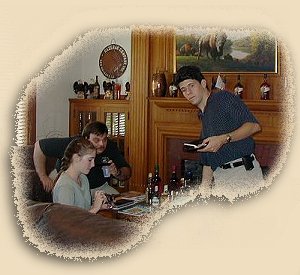 We meet the Giammarcos, Kris and Chris, the young couple who
drove from New York City since they couldn’t fly. While here, we bought
a copy of the new second edition of Sam Cecil’s book,
The
Evolution of the Bourbon Whiskey Industry in Kentucky . This
version sports a different cover, and among other changes, it has an index
-- pretty important for a reference book.
We meet the Giammarcos, Kris and Chris, the young couple who
drove from New York City since they couldn’t fly. While here, we bought
a copy of the new second edition of Sam Cecil’s book,
The
Evolution of the Bourbon Whiskey Industry in Kentucky . This
version sports a different cover, and among other changes, it has an index
-- pretty important for a reference book.
At 12:30 we meet in the parking lot of the My Old Kentucky Dinner Train with
several others for the long-awaited tasting party that Buffalo Trace brand
manager Ken Weber is putting on especially for those of us who have mostly
known one another through the bulletin board. The idea originated in an email
conversation between Ken and fellow member Omar Montejo way back in the early
spring, and they've been planning it all year. The others are Mike Veach,
Linn and Vickie, Kris and Chris, Marvin and Evelyn, and Bill. Unfortunately,
the grounding of commercial air traffic has left poor Omar unable to attend
the event he’d worked so hard on.
The event , held at the Buffalo
Trace distillery just outside of Frankfort, turns out to be truly
outstanding. It begins with the hour-long drive to Frankfort, with Ken and
Mike in the front seat holding a running conversation about bourbon history.
When we arrive at the distillery, we're given a complete tour of the plant.
For some, this is the first time they've ever seen a distillery and the tour
is a good one. When it is over, we proceed to the Stoney Point Mansion, high
on the hill above the distillery, for the buffet and tasting. Joining us
here is master distiller emeritus Elmer
T. Lee who tells fascinating stories about bourbon and the folks
who make it. We love visiting with Elmer. He must be about eighty-two now,
but he keeps looking better every time we see him. Most of us had brought
bottles of special bourbons to share, and Ken had some wonderful tidbits
as well, including some of Elmer’s own 107-proof (which is John's favorite
bourbon and which hasn't been sold for years). There was also some very old
bourbons from when this was the Stagg Distillery and even some corn
whiskey that Schenley used to sell.
There are chafing dishes with quiches, meatballs, and spicy chicken wings,
and fancy fruits and sweet snacks, as well. All of this is set in the gorgeous,
oak-panelled living room of what had once been Colonel Albert Blanton's personal
residence. Used now as offices and as the entertainment center for VIP guests,
we could hardly have asked for a more impressive backdrop for a very enjoyable
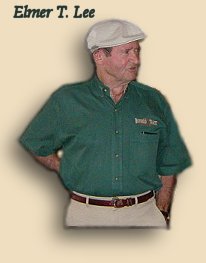 afternoon.
afternoon.
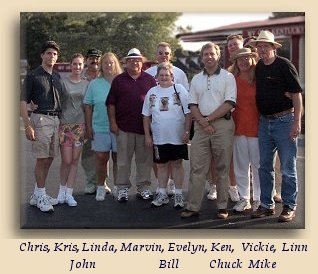 Afterward,
as we disembark from the van back at the parking lot in Bardstown, we can't
help but notice a stranger lurking in a parked car watching us. It turns
out to be none other than Chuck Cowdery, who has driven down from Chicago.
Chuck, known to the rest of the world as Charles K. Cowdery, is a popular
author of articles about American whiskey published by several magazines
in the United States and Europe. He's also the producer of a television special
about the history of bourbon in Kentucky, and he publishes his own quarterly
newsletter, the
Bourbon Country
Reader. Chuck, who is also involved in the online forum, knew
from the our messages that we'd planned to meet and leave from this parking
lot, so when he saw us gathered there as he arrived in town he figured it
was us and came over to join us. Several of us, including Chuck, head back
to the motel for more sampling, and then to dinner at
Kurtz
Restaurant. Linda and I have never eaten there before, but we will
now keep it on our "must do" list.
Afterward,
as we disembark from the van back at the parking lot in Bardstown, we can't
help but notice a stranger lurking in a parked car watching us. It turns
out to be none other than Chuck Cowdery, who has driven down from Chicago.
Chuck, known to the rest of the world as Charles K. Cowdery, is a popular
author of articles about American whiskey published by several magazines
in the United States and Europe. He's also the producer of a television special
about the history of bourbon in Kentucky, and he publishes his own quarterly
newsletter, the
Bourbon Country
Reader. Chuck, who is also involved in the online forum, knew
from the our messages that we'd planned to meet and leave from this parking
lot, so when he saw us gathered there as he arrived in town he figured it
was us and came over to join us. Several of us, including Chuck, head back
to the motel for more sampling, and then to dinner at
Kurtz
Restaurant. Linda and I have never eaten there before, but we will
now keep it on our "must do" list.
FRIDAY
-
SEPTEMBER
14,
2001
FESTIVAL
PRESS
PARTY
at
FOUR
ROSES
DISTILLERY
THIS MORNING we're planning to try getting
to the "Talking Bourbon" event, held at Seagram’s Four Roses Distillery
as part of the Bourbon Festival. This is a reserved event that we hadn't
planned on attending until the last minute, and so we don’t have tickets
or reservations for it. But we're hoping that, due to the light crowds this
year, we might have a chance to buy tickets and attend it at the last minute.
The Four Roses Distillery is in Lawrenceburg,
about a forty-five minute drive from Bardstown. We were planning to board
a bus which the festival has arranged to take visitors, but since Chuck is
going anyway, he offers to take us and Bill with him. As we're driving along
the beautiful Bluegrass Parkway, John's cell phone begins to ring. The caller
turns out to be none other than our missing Omar. He’s managed to get
onto the first commercial flight from Miami to Atlanta and after a string
of connections reminiscent of an old comedy movie, he is now in a rented
car, also on the Bluegrass Parkway, and headed toward Four Roses from the
other direction.
When we arrive at the distillery, the gate guard directs us along a road
leading up a hill and behind the buildings, where we find ourselves in a
setting somewhat different than what we'd anticipated. Apparently, this is
not the open-to-the-public "Talking Bourbon" event. This is the Kentucky
Bourbon Festival Press Party, and only invited members of the press are expected
be here. Chuck is among the invitees, and has a press pass awaiting him at
the check-in table. Also arriving to begin their festival at Four Roses,
we see Greg and Jo Kitzmiller. Greg, who lectures with the Indiana school
system, had obtained a press pass before coming. Linda, John, and Bill have
no such press
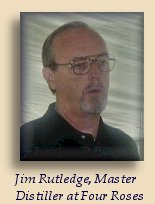 passes, but we try to look as official as possible. We'll never
really know how effective (or not) that might have been, though, because
soon afterward Omar arrives, and he immediately begins asking for Pam Gover,
the festival executive director. When she learns he is here she comes right
over and treats him as if they’d been old friends who hadn't seen one
another for years. In the meantime, no one says anything to us, and we all
go into the tented area together and take our seats.
passes, but we try to look as official as possible. We'll never
really know how effective (or not) that might have been, though, because
soon afterward Omar arrives, and he immediately begins asking for Pam Gover,
the festival executive director. When she learns he is here she comes right
over and treats him as if they’d been old friends who hadn't seen one
another for years. In the meantime, no one says anything to us, and we all
go into the tented area together and take our seats.
The presentation is given by Four Roses master distiller Jim Rutledge. It
really is a pretty thorough trip through the bourbon-making process, quite
a bit more detailed than what you'd find in a normal public tour. The people
here (which I dare say do include us, even if we don't have press credentials)
are obviously familiar and knowledgeable, and the presentation takes that
into consideration. There are nicely designed props, including colorful cutaway
models of the distillery equipment showing how a column still works. Jim’s
presentation includes some technical aspects of distilling that we've never
heard (or even read) anyone cover before. Unfortunately, the discussion is
severely hampered by the fact that the only cold, blustery wind of the entire
festival weekend has picked just this time to blow across this lovely hillside,
bringing discomfort to just about everyone gathered here under the tent canvas.
Even Jim, standing and wearing a light shirt, seems to be shivering and just
wishing this whole thing were over.
The presentation is followed by a tour of the distillery.
 While not to be compared with the personal tour we had with
Al Young, it's still a very good tour. When that's over, we have a chance
to taste some rare Four Roses bourbons that are not available in the United
States and to meet and mingle with distillers and important figures from
all the distilleries. Indeed, this looks to be a sort of Kentucky Bourbon
Festival of its own. Like the Black Tie Gala (which we are not attending
this year) just about everyone in the bourbon industry Who's Who seems
to be at this event. We get to meet Gary Gayheart, the current master distiller
at Buffalo Trace (and Ancient Age for years before that). And along with
a chance to say hi to Fred Noe, we get the opportunity to meet his father,
Booker, for the first time. Our old friends Lincoln Henderson and Jimmy Russell
are here, as is Bill Samuels and Jerry Dalton and so many others. We get
to visit for awhile with Al Young, who proudly tells us that he's now a
grandfather. And we meet Colonel Mike Masters, author of the cookbook,
"Hospitality, Kentucky
Style".
While not to be compared with the personal tour we had with
Al Young, it's still a very good tour. When that's over, we have a chance
to taste some rare Four Roses bourbons that are not available in the United
States and to meet and mingle with distillers and important figures from
all the distilleries. Indeed, this looks to be a sort of Kentucky Bourbon
Festival of its own. Like the Black Tie Gala (which we are not attending
this year) just about everyone in the bourbon industry Who's Who seems
to be at this event. We get to meet Gary Gayheart, the current master distiller
at Buffalo Trace (and Ancient Age for years before that). And along with
a chance to say hi to Fred Noe, we get the opportunity to meet his father,
Booker, for the first time. Our old friends Lincoln Henderson and Jimmy Russell
are here, as is Bill Samuels and Jerry Dalton and so many others. We get
to visit for awhile with Al Young, who proudly tells us that he's now a
grandfather. And we meet Colonel Mike Masters, author of the cookbook,
"Hospitality, Kentucky
Style".
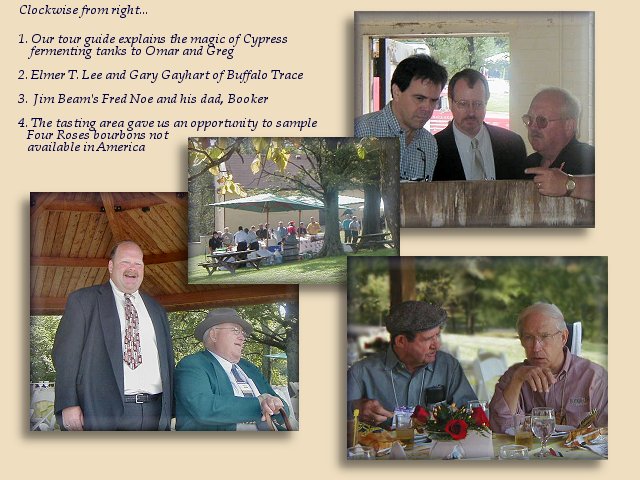
The Kentucky Bourbon Festival's main musical attraction this year is the
band The Kentucky
Headhunters. They will be the featured act at the festival grounds
Saturday night, but they're here to perform at this event today. There's
also a full luncheon and who knows what all else, but like Cinderella at
the ball, we have to leave early in order to get back to Bardstown for the
Bourbon Heritage Panel. Chuck is scheduled to be a panel member, so he needs
to be back at least a half hour before the show is to begin. We make it with
time to spare, and while Chuck is getting ready, we and Bill grab a bite
at Xavier’s Restaurant, located in the basement of Spalding Hall. Well,
this is now another addition to our "must do" list.
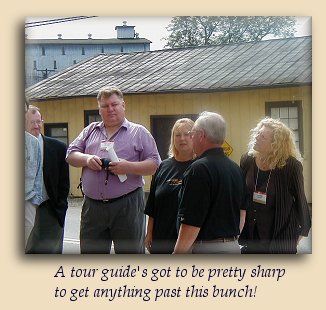 There
is a front door to Xavier's, but apparently it isn't open for lunch. Instead,
you have to enter by way of the kitchen door, which is also a bakery, and
then go into the restaurant from there. Once inside, though, it's really
nice. It's full of arches and nooks and looks like a romantic place to have
dinner. Lunch is simple, but delicious, and we finish just in time to go
upstairs and take our seats for the Bourbon Heritage Panel.
There
is a front door to Xavier's, but apparently it isn't open for lunch. Instead,
you have to enter by way of the kitchen door, which is also a bakery, and
then go into the restaurant from there. Once inside, though, it's really
nice. It's full of arches and nooks and looks like a romantic place to have
dinner. Lunch is simple, but delicious, and we finish just in time to go
upstairs and take our seats for the Bourbon Heritage Panel.
BOURBON
HERITAGE
PANEL
DISCUSSION
THIS YEAR the panel,
emceed as always by Mike
Veach, consists of Jerry Dalton, who made whiskey for years at Barton and
is now master distiller for Jim Beam; Chuck Cowdery; Dave Pickerell, who
is Maker's Mark's general manager; the legendary Buddy Thompson, who was
the owner of the Glenmore distillery in Owensboro when it was in its prime;
and
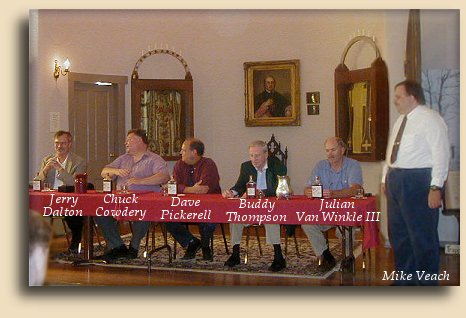 the
equally legendary Julian Van Winkle III, president of Old Rip Van Winkle.
the
equally legendary Julian Van Winkle III, president of Old Rip Van Winkle.
Mike usually has a couple of ideas in mind that he'd like the panel to focus
on, and he doesn't spend a lot of time "sneaking up" on the subjects. With
a writer of bourbon history and representatives from four distilleries heavily
steeped in family tradition on the panel, Mike starts right off by turning
the discussion to how bourbon history has been affected by the traditions
of the bourbon-making families.
The renowned Stitzel-Weller distillery remains an icon in the world of bourbon
whiskey even today, thirty years after it passed from the Van Winkle family's
ownership and a full decade after the last drop of whiskey was distilled
there. More than just its memory lingers on, though. Many bottles of fine
Old Fitzgerald and Old Weller bourbon, made at Stitzel-Weller, are still
available on store shelves today, although the whiskey in these bottles won't
have been made by the Van Winkle family. Bottles from those days (mid-'70s
and earlier) are scarce collectors' items. However, Julian's own brands,
Old Rip Van Winkle and Van Winkle Family Reserve, are considered among the
most excellent bourbon whiskey ever produced.
Dave Pickerell represents the Star Hill distillery run by the Samuels family,
which is much better known by the name of its only product, Maker's Mark
bourbon. The Samuels family whiskey-making tradition goes back seven generations,
but, according to the company bio, that was about five generations of
not-so-great whiskey. On the Maker's Mark web page, current president Bill
Samuels, Jr. quotes his mother as saying it "could blow yer ears off". In
the early 1950s Bill's father, T. William (Bill Sr.) Samuels made the radical
decision to break from that family tradition and produce a high-quality bourbon
he could be proud of. His desire to separate the "new" Samuels product from
the old involved not only a new recipe, new yeast, and moving from the old
distillery near Bardstown to a farm in Loretto, but went even so far as to
abandon the old brand name, which was his family name. Today, the T.W. Samuels
distillery no longer makes bourbon (although fine spring water is bottled
at the site), but the brand still lives on as a Heaven Hill "commemorative"
label. And the Maker's Mark label and distillery is now actually owned by
Allied Domecq, a French conglomerate. Nevertheless, the real T. William
Samuels (Bill Jr.) is running the distillery, just as his father did. And
the (now much improved for the past two generations) family tradition lives
on.
For most people not intimately familiar with the whiskey business, it's hard
to hear to hear the word "bourbon" and not think of the Beam family. For
those who are familiar, it's impossible. Not only the branch of the
family that provides us with the largest-selling bourbon on the planet, Jim
Beam, but no less than two other major branches of the Beam family have provided
important parts of the bourbon whiskey story. The number of bourbon brands,
past and present, that have not had a Beam in their history somewhere are
very few indeed. As master distiller for Jim Beam Brands, Jerry Dalton gives
us some insights into that branch of the family.
Another old, old, Kentucky family whose members helped shaped the history
of bourbonmaking over the last two hundred or so years is one with several
branches and combinations of branches. It includes the descendants of John
Thompson Street (JTS) Brown, and is represented today by Owsley Brown
II, CEO of Brown-Forman, Inc. (Old Forester, Early Times, Labrot & Graham)
and Buddy Thompson, whose branch of the family owned Glenmore Distillery
until it was bought out by United Distillers in 1991. Glenmore, located in
Owensboro, about a hundred miles down the Ohio River from Louisville, was
one of the giants in the industry. And during this time the Thompson family
owned and operated it.
As one of the premier chroniclers of all this bourbon history (and more),
Chuck Cowdery brings to the discussion the ability to tie all these fine
stories together and show how each of these families influenced one another
over the generations. Of all these great family enterprises, only one (Heaven
Hill, who is intimately involved in the Bourbon Festival but unable to
participate today) is still completely family-owned by the Shapiras, as it
has been since its founding in 1934. And, although Brown-Forman is a large
corporation, with other businesses such as wine, leather goods and chinaware,
the Brown family has always been in control. Others have changed over the
years, especially recently, and that is the subject of much of today's discussion
as well.
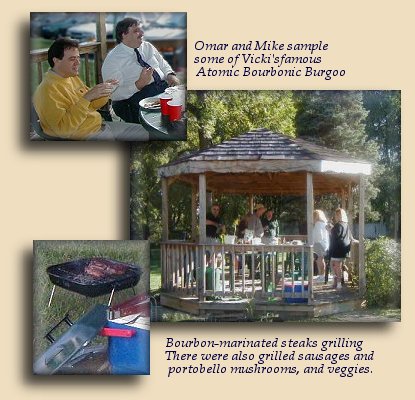 This
afternoon we have a cookout at the motel, as we and several others set up
the little charcoal grill that Linda bought for the occasion, and haul many,
many bottles of fine Kentucky Bourbon to the gazebo, located in the back.
We have brought bourbon-marinated steaks and home-made guacamole for the
affair. Mike proudly offers his delicious Bourbonated Baked Beans. Linn and
Vickie pass out bowls of Vicki's Famous Atomic Bourbonic Burgoo, a big hit.
Bill has brought us all Labrot & Graham bourbon chocolates. Greg and
Jo have snack veggies and some great Portobello mushrooms to grill,
and Chuck has smoked sausages, which we also grill. Omar is here, and so
is Kris and Chris.
This
afternoon we have a cookout at the motel, as we and several others set up
the little charcoal grill that Linda bought for the occasion, and haul many,
many bottles of fine Kentucky Bourbon to the gazebo, located in the back.
We have brought bourbon-marinated steaks and home-made guacamole for the
affair. Mike proudly offers his delicious Bourbonated Baked Beans. Linn and
Vickie pass out bowls of Vicki's Famous Atomic Bourbonic Burgoo, a big hit.
Bill has brought us all Labrot & Graham bourbon chocolates. Greg and
Jo have snack veggies and some great Portobello mushrooms to grill,
and Chuck has smoked sausages, which we also grill. Omar is here, and so
is Kris and Chris.
As a refreshing change from our normal routine, we spend the afternoon eating,
talking, and sipping fine bourbon (from plastic cups)
SATURDAY
-
SEPTEMBER
15,
2001
WE EXPLORE the festival grounds this
morning, looking for the site of the Barbeque Cook-off. We see signs for it,
and it's mentioned in the festival flyer, but there doesn't appear to be
anything set up for it, and no one we ask seems to know anything about it.
 But while looking, we spend a few minutes visiting the car show,
which is just a few display hot rods and restored cars, mostly from the local
Whiskey City Cruisers hot rod club. The ones we have at home in the WalMart
parking lot are much more impressive. And that's surprising, too, since there's
a strong historic connection between whiskey distillers and the drivers of
hot rod automobiles. Some say that the whole idea of a outfitting a
"stock"-looking car with a big motor and heavy-duty suspension derives from
a common method of distribution for, shall we say, unlicensed whiskey
makers. In the days before police radios, the successful marketing of beverage
spirits often involved outrunning a patrol car or two.
But while looking, we spend a few minutes visiting the car show,
which is just a few display hot rods and restored cars, mostly from the local
Whiskey City Cruisers hot rod club. The ones we have at home in the WalMart
parking lot are much more impressive. And that's surprising, too, since there's
a strong historic connection between whiskey distillers and the drivers of
hot rod automobiles. Some say that the whole idea of a outfitting a
"stock"-looking car with a big motor and heavy-duty suspension derives from
a common method of distribution for, shall we say, unlicensed whiskey
makers. In the days before police radios, the successful marketing of beverage
spirits often involved outrunning a patrol car or two.
And we also get to see the famous Barrel Rolling competition for the first
time. This is a major attraction, especially for the many people who work
in the distilleries. There are men's, women's, and team divisions and the
competition is keen.
Its a "fun" event, but it's certainly not a "goofy" one. The competition
is as serious as in any other sport and the teams and individual athletes
work at it all year (in the men's event it's not likely that anyone but
professional barrel handlers would qualify to be contestants). It's also
considerably more demanding and dangerous than, say, a company bowling or
baseball team; these are full barrels, weighing around 500 lbs each. It takes
muscles to start them, and once moving they're not easy to stop or turn.
Each contestant needs to roll one barrel along a wooden track with absolutely
no room for error, stopping halfway to make a right-angle turn. She then
needs to stop the barrel, at the end of the track, this time on an exact
mark. She must turn it, wrestle it around until it's lined it up precisely
so that the bung in the side of the barrel will be pointed straight up when
it gets to the end of the rack, and then run it home.
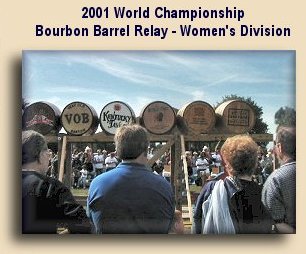 Points are taken for even the slightest deviation from straight
up. In the photo on the right, both the VOB and Kentucky Tavern barrels would
be considered "off". She needs to place five barrels in the rack to complete
the race, and of course the starting alignment will need to be different
for each barrel she does. And all of this is being run against the stopwatch
and accompanied by the cheers of her team and the crowd
Points are taken for even the slightest deviation from straight
up. In the photo on the right, both the VOB and Kentucky Tavern barrels would
be considered "off". She needs to place five barrels in the rack to complete
the race, and of course the starting alignment will need to be different
for each barrel she does. And all of this is being run against the stopwatch
and accompanied by the cheers of her team and the crowd
By the time we get back out to where the food concessions are, we're more
than ready for a Blue- cheese ‘n’Barbeque wrap for lunch.
GETZ
MUSEUM
MASTER
DISTILLER'S
AUCTION
Around noon, Linda volunteers to go over and help out at the Master
Distillers’ Auction where Mike and Flaget put her to work, along with
Marnie Keesy, copying and collating all the auction item lists. We also visit
with Jo and Jean Beam.
If there were fewer people at the Festival this year, you sure wouldn't know
it from the Master Distillers' Auction. The room is packed, with rows of
people standing in the back. Auctioneer Karl Lusk gets the bidding going
and works the crowd to a minor frenzy. Bids are flying, and in the melee
John manages to come away with a pint bottle of Early Times bourbon from
the ‘60s (when they made bourbon) and Linda snags a bottle of Mount
Vernon Rye from the ‘30s.
After the auction, we take Bill over to the food vendors’ court to introduce
him to Blue-cheese ‘n’Barbeque wraps for dinner, so we're pretty
well stuffed when Chuck and Linn stop by our motel room a little later to
invite us to join them for dinner at Talbot’s Tavern. Greg and Jo are
going, too. Not long after they leave, though, we decide to walk over to
the tavern and join them for drinks and maybe an appetizer. As we strolled
back to Spalding Hall, for Mike's Academy of American Whiskey event , we
spot Marvin and Evelyn sitting on the porch of Jailer’s Inn, the
bed’n’breakfast where they're staying this year.
OSCAR
GETZ
ACADEMY of AMERICAN
WHISKEY
This evening at Spalding Hall, Mike, Chuck, and United Distillers master
distiller Ed Foote are conducting the first annual Academy of American Whiskey
for the benefit of new bourbon enthusiasts. It's also for the benefit of
the Oscar Getz Museum, as there is a fee for this event. We've come to lend
moral support and help out. And besides, Chuck and Mike are involved and
we think it'll be a gas.
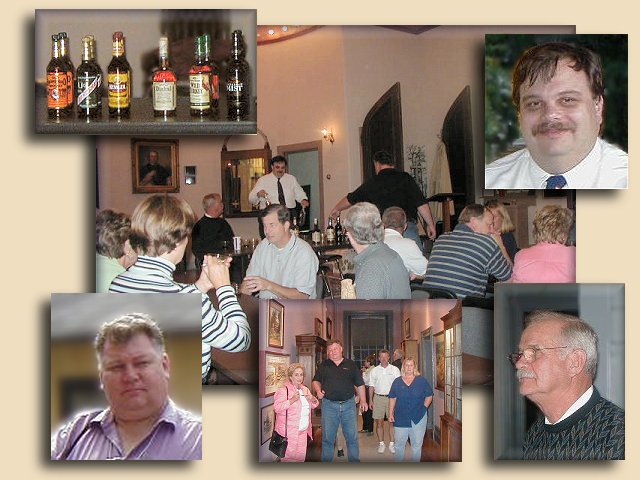
The basic planning for the evening is pretty good, the idea being that
we will sample six different types of American whiskey and learn what makes
them different from one another. The six whiskeys are,
-
Old Grand Dad, a traditional bourbon made with rye
-
Old Fitzgerald , a wheated bourbon
-
Kessler, an American blended whiskey
-
George Dickel, a Tennessee Whisky
-
Wild Turkey Rye, a rye whiskey, and
-
Canadian Mist, a Canadian Whisky
Among Mike, Ed, and Chuck there is a lot of discussion about each of the
types and the elements that identify them. Unfortunately, the discussion
proves to be the weak point of the presentation. There is just no structure
at all to it. With no agreed-upon idea of what the tasting is supposed to
illustrate, the three leaders tend to ramble on from one subject to the next
with no direction. The historian, the master distiller, and the specialty
writer each seem to be discussing subjects at their own level, speaking in
trade jargon that no one else understands. Chuck, who is experienced at directing
information toward an audience, valiantly tries to guide and focus the
conversation a bit. But the people at our table seem to be quickly overwhelmed
by the experience.
Following the tastings is an "exam", in which an unknown whiskey is poured
and we are supposed to place it into the correct category. It turns out to
be one of the wheated Old Rip Van Winkle bottlings, and we're surprised that
John is the only one to get it correctly. The evening ends with an in-depth
tour of the
museum.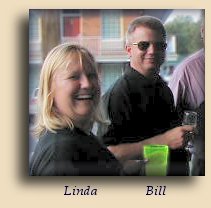
Tonight is basically the final night for partying.
 Linn
and Vickie’s motel room quickly becomes both too full and too noisy
for comfort and good neighborliness, so we begin moving everything out to
the gazebo. Now, the gazebo's not quite empty; there's a couple, Peggy and
Todd Forbes, who are sitting in there, just relaxing from the day and smoking
cigars when we begin to descend upon it. They've come here for the bourbon
festival, but they probably weren’t anticipating getting caught up with
this mob. Nevertheless, within only a few minutes they become part of the
party (and have since joined and contributed to the online forum). It's a
little reminiscent of the scene from Bonnie and Clyde where they kidnap Eugene
and Velma.
Linn
and Vickie’s motel room quickly becomes both too full and too noisy
for comfort and good neighborliness, so we begin moving everything out to
the gazebo. Now, the gazebo's not quite empty; there's a couple, Peggy and
Todd Forbes, who are sitting in there, just relaxing from the day and smoking
cigars when we begin to descend upon it. They've come here for the bourbon
festival, but they probably weren’t anticipating getting caught up with
this mob. Nevertheless, within only a few minutes they become part of the
party (and have since joined and contributed to the online forum). It's a
little reminiscent of the scene from Bonnie and Clyde where they kidnap Eugene
and Velma.
Linn and Vickie, Greg and Jo, Mike, Omar, Chuck, and Bill are all here. We
had seen Kris and Chris earlier, dressed in their evening wear. They're attending
the formal Black Tie Gala, which we did last year, and we hoped they’d
join us afterward, but we don't see them again this evening. We do see some
others, though. Chris and Cathy Sigmon are among them.
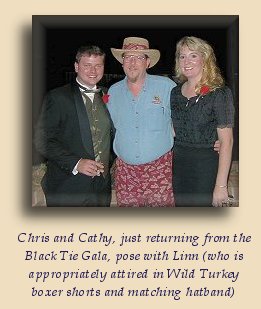 Chris
was a major buyer at the auction this afternoon and they're having the time
of their lives. Julian Van Winkle had been with other people when they returned
from the Black Tie Gala, but he changes into more casual clothes and joins
us soon afterward.
Chris
was a major buyer at the auction this afternoon and they're having the time
of their lives. Julian Van Winkle had been with other people when they returned
from the Black Tie Gala, but he changes into more casual clothes and joins
us soon afterward.
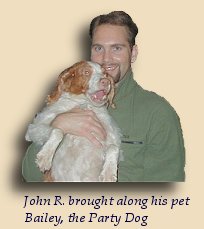 John
Roberts, another who we've met online, has arrived from Tennessee just in
time to catch the end of the festival. He is accompanied by his dog Bailey.
Bailey is named for the Irish Creme cordial her coloring resembles and she
is a true party animal.
John
Roberts, another who we've met online, has arrived from Tennessee just in
time to catch the end of the festival. He is accompanied by his dog Bailey.
Bailey is named for the Irish Creme cordial her coloring resembles and she
is a true party animal.
Tonight the party continues on into the early hours. As we're leaving, only
John Roberts and Greg remain. Greg (more than a little inebriated) has decided
that now would be just a fine time to set up his laptop computer out on the
gazebo table and write an article to the New York Times. And we believe he
could do it, too...
... if he could only feel his fingers.
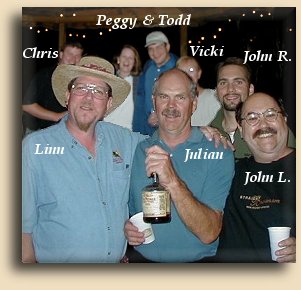 SUNDAY
-
SEPTEMBER
16,
2001
SUNDAY
-
SEPTEMBER
16,
2001
This morning we said goodbye to as many friends as we could see. We have
breakfast at the Stephen Foster Buffet with Bill and then the three of us
walk over to the festival grounds to see if we can find Sam Cecil and get
him to autograph our copy of his book. We talk to Colonel Masters again while
waiting and eventually Sam does arrive and signs our copy. We also visit
awhile with Jimmy Russell and he signs an article written about him in the
current edition of Whisky Magazine.
We drive home this afternoon. As we return to the "real" world, we have a
feeling of anxiety over the changes that have so suddenly taken place. But
then we get home...
We open the door;
Soft fur brushes our ankles.
Three tails stand straight
up.
Meow!
Some things don't change.

 The
history of bourbon and the history of America are very much one and the same.
And, unfortunately, the premier celebration of this noble spirit coincided
this year with a tragic event that will forever be engraved in our hearts
and in American history.
The
history of bourbon and the history of America are very much one and the same.
And, unfortunately, the premier celebration of this noble spirit coincided
this year with a tragic event that will forever be engraved in our hearts
and in American history.
 There
were very many others who did the same.
There
were very many others who did the same.


 We meet the Giammarcos, Kris and Chris, the young couple who
drove from New York City since they couldn’t fly. While here, we bought
a copy of the new second edition of Sam Cecil’s book,
The
Evolution of the Bourbon Whiskey Industry in Kentucky . This
version sports a different cover, and among other changes, it has an index
-- pretty important for a reference book.
We meet the Giammarcos, Kris and Chris, the young couple who
drove from New York City since they couldn’t fly. While here, we bought
a copy of the new second edition of Sam Cecil’s book,
The
Evolution of the Bourbon Whiskey Industry in Kentucky . This
version sports a different cover, and among other changes, it has an index
-- pretty important for a reference book.
 afternoon.
afternoon.
 Afterward,
as we disembark from the van back at the parking lot in Bardstown, we can't
help but notice a stranger lurking in a parked car watching us. It turns
out to be none other than Chuck Cowdery, who has driven down from Chicago.
Chuck, known to the rest of the world as Charles K. Cowdery, is a popular
author of articles about American whiskey published by several magazines
in the United States and Europe. He's also the producer of a television special
about the history of bourbon in Kentucky, and he publishes his own quarterly
newsletter, the
Bourbon Country
Reader. Chuck, who is also involved in the online forum, knew
from the our messages that we'd planned to meet and leave from this parking
lot, so when he saw us gathered there as he arrived in town he figured it
was us and came over to join us. Several of us, including Chuck, head back
to the motel for more sampling, and then to dinner at
Kurtz
Restaurant. Linda and I have never eaten there before, but we will
now keep it on our "must do" list.
Afterward,
as we disembark from the van back at the parking lot in Bardstown, we can't
help but notice a stranger lurking in a parked car watching us. It turns
out to be none other than Chuck Cowdery, who has driven down from Chicago.
Chuck, known to the rest of the world as Charles K. Cowdery, is a popular
author of articles about American whiskey published by several magazines
in the United States and Europe. He's also the producer of a television special
about the history of bourbon in Kentucky, and he publishes his own quarterly
newsletter, the
Bourbon Country
Reader. Chuck, who is also involved in the online forum, knew
from the our messages that we'd planned to meet and leave from this parking
lot, so when he saw us gathered there as he arrived in town he figured it
was us and came over to join us. Several of us, including Chuck, head back
to the motel for more sampling, and then to dinner at
Kurtz
Restaurant. Linda and I have never eaten there before, but we will
now keep it on our "must do" list.
 passes, but we try to look as official as possible. We'll never
really know how effective (or not) that might have been, though, because
soon afterward Omar arrives, and he immediately begins asking for Pam Gover,
the festival executive director. When she learns he is here she comes right
over and treats him as if they’d been old friends who hadn't seen one
another for years. In the meantime, no one says anything to us, and we all
go into the tented area together and take our seats.
passes, but we try to look as official as possible. We'll never
really know how effective (or not) that might have been, though, because
soon afterward Omar arrives, and he immediately begins asking for Pam Gover,
the festival executive director. When she learns he is here she comes right
over and treats him as if they’d been old friends who hadn't seen one
another for years. In the meantime, no one says anything to us, and we all
go into the tented area together and take our seats.
 While not to be compared with the personal tour we had with
Al Young, it's still a very good tour. When that's over, we have a chance
to taste some rare Four Roses bourbons that are not available in the United
States and to meet and mingle with distillers and important figures from
all the distilleries. Indeed, this looks to be a sort of Kentucky Bourbon
Festival of its own. Like the Black Tie Gala (which we are not attending
this year) just about everyone in the bourbon industry Who's Who seems
to be at this event. We get to meet Gary Gayheart, the current master distiller
at Buffalo Trace (and Ancient Age for years before that). And along with
a chance to say hi to Fred Noe, we get the opportunity to meet his father,
Booker, for the first time. Our old friends Lincoln Henderson and Jimmy Russell
are here, as is Bill Samuels and Jerry Dalton and so many others. We get
to visit for awhile with Al Young, who proudly tells us that he's now a
grandfather. And we meet Colonel Mike Masters, author of the cookbook,
"Hospitality, Kentucky
Style".
While not to be compared with the personal tour we had with
Al Young, it's still a very good tour. When that's over, we have a chance
to taste some rare Four Roses bourbons that are not available in the United
States and to meet and mingle with distillers and important figures from
all the distilleries. Indeed, this looks to be a sort of Kentucky Bourbon
Festival of its own. Like the Black Tie Gala (which we are not attending
this year) just about everyone in the bourbon industry Who's Who seems
to be at this event. We get to meet Gary Gayheart, the current master distiller
at Buffalo Trace (and Ancient Age for years before that). And along with
a chance to say hi to Fred Noe, we get the opportunity to meet his father,
Booker, for the first time. Our old friends Lincoln Henderson and Jimmy Russell
are here, as is Bill Samuels and Jerry Dalton and so many others. We get
to visit for awhile with Al Young, who proudly tells us that he's now a
grandfather. And we meet Colonel Mike Masters, author of the cookbook,
"Hospitality, Kentucky
Style". 
 There
is a front door to Xavier's, but apparently it isn't open for lunch. Instead,
you have to enter by way of the kitchen door, which is also a bakery, and
then go into the restaurant from there. Once inside, though, it's really
nice. It's full of arches and nooks and looks like a romantic place to have
dinner. Lunch is simple, but delicious, and we finish just in time to go
upstairs and take our seats for the Bourbon Heritage Panel.
There
is a front door to Xavier's, but apparently it isn't open for lunch. Instead,
you have to enter by way of the kitchen door, which is also a bakery, and
then go into the restaurant from there. Once inside, though, it's really
nice. It's full of arches and nooks and looks like a romantic place to have
dinner. Lunch is simple, but delicious, and we finish just in time to go
upstairs and take our seats for the Bourbon Heritage Panel.
 the
equally legendary Julian Van Winkle III, president of Old Rip Van Winkle.
the
equally legendary Julian Van Winkle III, president of Old Rip Van Winkle.
 This
afternoon we have a cookout at the motel, as we and several others set up
the little charcoal grill that Linda bought for the occasion, and haul many,
many bottles of fine Kentucky Bourbon to the gazebo, located in the back.
We have brought bourbon-marinated steaks and home-made guacamole for the
affair. Mike proudly offers his delicious Bourbonated Baked Beans. Linn and
Vickie pass out bowls of Vicki's Famous Atomic Bourbonic Burgoo, a big hit.
Bill has brought us all Labrot & Graham bourbon chocolates. Greg and
Jo have snack veggies and some great Portobello mushrooms to grill,
and Chuck has smoked sausages, which we also grill. Omar is here, and so
is Kris and Chris.
This
afternoon we have a cookout at the motel, as we and several others set up
the little charcoal grill that Linda bought for the occasion, and haul many,
many bottles of fine Kentucky Bourbon to the gazebo, located in the back.
We have brought bourbon-marinated steaks and home-made guacamole for the
affair. Mike proudly offers his delicious Bourbonated Baked Beans. Linn and
Vickie pass out bowls of Vicki's Famous Atomic Bourbonic Burgoo, a big hit.
Bill has brought us all Labrot & Graham bourbon chocolates. Greg and
Jo have snack veggies and some great Portobello mushrooms to grill,
and Chuck has smoked sausages, which we also grill. Omar is here, and so
is Kris and Chris.
 But while looking, we spend a few minutes visiting the car show,
which is just a few display hot rods and restored cars, mostly from the local
Whiskey City Cruisers hot rod club. The ones we have at home in the WalMart
parking lot are much more impressive. And that's surprising, too, since there's
a strong historic connection between whiskey distillers and the drivers of
hot rod automobiles. Some say that the whole idea of a outfitting a
"stock"-looking car with a big motor and heavy-duty suspension derives from
a common method of distribution for, shall we say, unlicensed whiskey
makers. In the days before police radios, the successful marketing of beverage
spirits often involved outrunning a patrol car or two.
But while looking, we spend a few minutes visiting the car show,
which is just a few display hot rods and restored cars, mostly from the local
Whiskey City Cruisers hot rod club. The ones we have at home in the WalMart
parking lot are much more impressive. And that's surprising, too, since there's
a strong historic connection between whiskey distillers and the drivers of
hot rod automobiles. Some say that the whole idea of a outfitting a
"stock"-looking car with a big motor and heavy-duty suspension derives from
a common method of distribution for, shall we say, unlicensed whiskey
makers. In the days before police radios, the successful marketing of beverage
spirits often involved outrunning a patrol car or two.
 Points are taken for even the slightest deviation from straight
up. In the photo on the right, both the VOB and Kentucky Tavern barrels would
be considered "off". She needs to place five barrels in the rack to complete
the race, and of course the starting alignment will need to be different
for each barrel she does. And all of this is being run against the stopwatch
and accompanied by the cheers of her team and the crowd
Points are taken for even the slightest deviation from straight
up. In the photo on the right, both the VOB and Kentucky Tavern barrels would
be considered "off". She needs to place five barrels in the rack to complete
the race, and of course the starting alignment will need to be different
for each barrel she does. And all of this is being run against the stopwatch
and accompanied by the cheers of her team and the crowd


 Linn
and Vickie’s motel room quickly becomes both too full and too noisy
for comfort and good neighborliness, so we begin moving everything out to
the gazebo. Now, the gazebo's not quite empty; there's a couple, Peggy and
Todd Forbes, who are sitting in there, just relaxing from the day and smoking
cigars when we begin to descend upon it. They've come here for the bourbon
festival, but they probably weren’t anticipating getting caught up with
this mob. Nevertheless, within only a few minutes they become part of the
party (and have since joined and contributed to the online forum). It's a
little reminiscent of the scene from Bonnie and Clyde where they kidnap Eugene
and Velma.
Linn
and Vickie’s motel room quickly becomes both too full and too noisy
for comfort and good neighborliness, so we begin moving everything out to
the gazebo. Now, the gazebo's not quite empty; there's a couple, Peggy and
Todd Forbes, who are sitting in there, just relaxing from the day and smoking
cigars when we begin to descend upon it. They've come here for the bourbon
festival, but they probably weren’t anticipating getting caught up with
this mob. Nevertheless, within only a few minutes they become part of the
party (and have since joined and contributed to the online forum). It's a
little reminiscent of the scene from Bonnie and Clyde where they kidnap Eugene
and Velma.
 Chris
was a major buyer at the auction this afternoon and they're having the time
of their lives. Julian Van Winkle had been with other people when they returned
from the Black Tie Gala, but he changes into more casual clothes and joins
us soon afterward.
Chris
was a major buyer at the auction this afternoon and they're having the time
of their lives. Julian Van Winkle had been with other people when they returned
from the Black Tie Gala, but he changes into more casual clothes and joins
us soon afterward.
 John
Roberts, another who we've met online, has arrived from Tennessee just in
time to catch the end of the festival. He is accompanied by his dog Bailey.
Bailey is named for the Irish Creme cordial her coloring resembles and she
is a true party animal.
John
Roberts, another who we've met online, has arrived from Tennessee just in
time to catch the end of the festival. He is accompanied by his dog Bailey.
Bailey is named for the Irish Creme cordial her coloring resembles and she
is a true party animal.
 SUNDAY
-
SEPTEMBER
16,
2001
SUNDAY
-
SEPTEMBER
16,
2001





